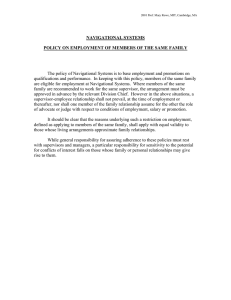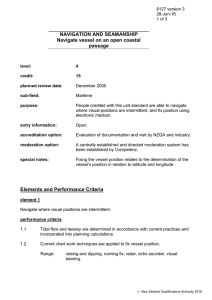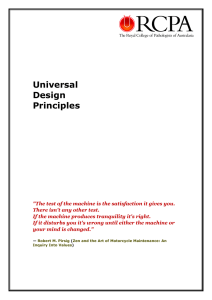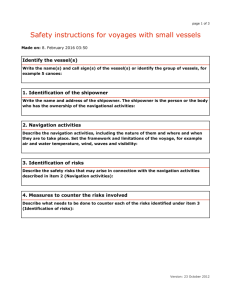NAVIGATION AND SEAMANSHIP Navigate in confined waters
advertisement
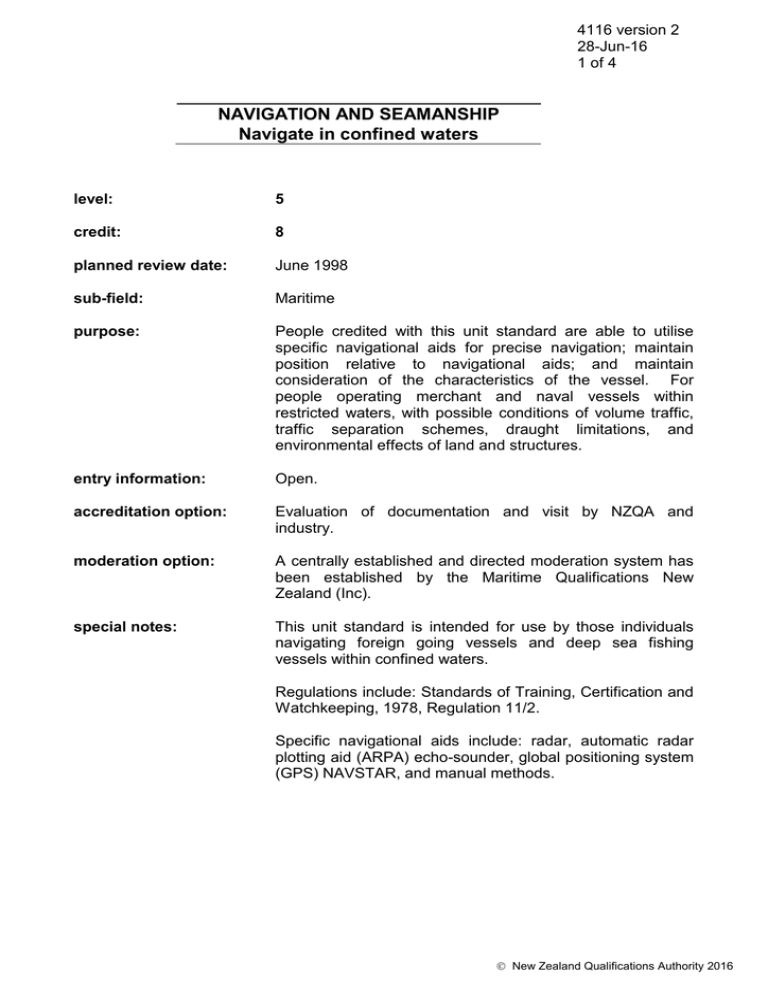
4116 version 2 28-Jun-16 1 of 4 NAVIGATION AND SEAMANSHIP Navigate in confined waters level: 5 credit: 8 planned review date: June 1998 sub-field: Maritime purpose: People credited with this unit standard are able to utilise specific navigational aids for precise navigation; maintain position relative to navigational aids; and maintain consideration of the characteristics of the vessel. For people operating merchant and naval vessels within restricted waters, with possible conditions of volume traffic, traffic separation schemes, draught limitations, and environmental effects of land and structures. entry information: Open. accreditation option: Evaluation of documentation and visit by NZQA and industry. moderation option: A centrally established and directed moderation system has been established by the Maritime Qualifications New Zealand (Inc). special notes: This unit standard is intended for use by those individuals navigating foreign going vessels and deep sea fishing vessels within confined waters. Regulations include: Standards of Training, Certification and Watchkeeping, 1978, Regulation 11/2. Specific navigational aids include: radar, automatic radar plotting aid (ARPA) echo-sounder, global positioning system (GPS) NAVSTAR, and manual methods. New Zealand Qualifications Authority 2016 4116 version 2 28-Jun-16 2 of 4 NAVIGATION AND SEAMANSHIP Navigate in confined waters Confined waters navigation occurs between coastal navigation and pilotage, and involves the application of navigational techniques to a degree of precision and frequency above that utilised during coastal navigation. Contingencies affecting position of vessel’s can include: weather, sea condition, tidal stream, and other traffic. Rendezvous may occur with pilot vessels, customs, agriculture and fishing vessel’s. Skill and knowledge supporting this unit standard includes: equipment operation, contingencies and responses, cause and effect, effect and response to channel effect and squat. Elements and Performance Criteria element 1 Obtain vessel position, speed, heading and track for precise navigation. performance criteria 1.1 Vessel is maintained in its planned position in relation to direction, heading, speed, and position. 1.2 Vessel heading is altered within safe limits to avoid identified hazards. 1.3 Contingencies impacting the maintenance of the vessel’s planned route are anticipated and action is implemented to alter the heading of vessel in advance of the contingency occurring. 1.4 Rendezvous are completed as directed and the vessel’s relative position is maintained during the transfer of personnel. New Zealand Qualifications Authority 2016 4116 version 2 28-Jun-16 3 of 4 NAVIGATION AND SEAMANSHIP Navigate in confined waters element 2 Utilise specific navigational aids and techniques for precise navigation. performance criteria 2.1 Correct navigational aid or technique is selected for the present and anticipated navigational situation facing the vessel. Range: situations facing the vessel can include: complexity of the approach, vessel status (draught, dimensions), operational status, personnel, other equipment, weather conditions. 2.2 Information and data on the vessel’s position and the surrounding environment presented on electronic navigational aids are confirmed as useable information and data, and are within the equipment’s readout accuracys and limitations. 2.3 Where such systems are in operation, vessel traffic system (VTS) reporting conditions and directions are responded to in accordance with local VTS instructions. 2.4 Manual navigational techniques and equipment are used appropriately and in accordance with any orders received from the ship’s master. New Zealand Qualifications Authority 2016 4116 version 2 28-Jun-16 4 of 4 NAVIGATION AND SEAMANSHIP Navigate in confined waters Comments to: Maritime Qualifications New Zealand (Inc) Unit Standard Revision PO Box 160 WELLINGTON by June 1998. Please Note: Providers must be accredited by the Qualifications Authority before they can offer programmes of education and training assessed against unit standards. Accredited providers assessing against unit standards must engage with the moderation system that applies to those unit standards. [Please refer to relevant Plan ref: 0054] New Zealand Qualifications Authority 2016



